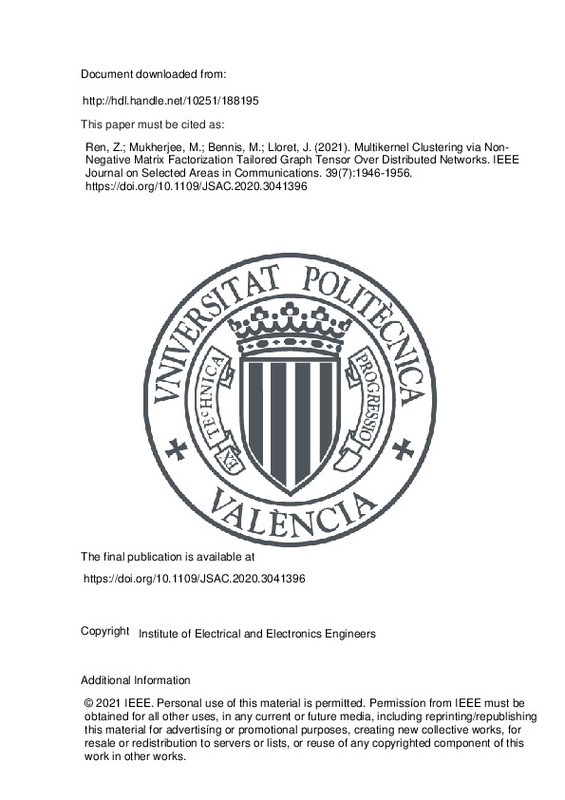Ren, Z.; Mukherjee, M.; Bennis, M.; Lloret, J. (2021). Multikernel Clustering via Non-Negative Matrix Factorization Tailored Graph Tensor Over Distributed Networks. IEEE Journal on Selected Areas in Communications. 39(7):1946-1956. https://doi.org/10.1109/JSAC.2020.3041396
Por favor, use este identificador para citar o enlazar este ítem: http://hdl.handle.net/10251/188195
|
Título:
|
Multikernel Clustering via Non-Negative Matrix Factorization Tailored Graph Tensor Over Distributed Networks
|
|
Autor:
|
Ren, Zhenwen
Mukherjee, Mithun
Bennis, Mehdi

 Lloret, Jaime
Lloret, Jaime
|
|
Entidad UPV:
|
Universitat Politècnica de València. Departamento de Comunicaciones - Departament de Comunicacions
|
|
Fecha difusión:
|
|
|
Resumen:
|
[EN] Next-generation wireless networks are witnessing an increasing number of clustering applications, and produce a large amount of non-linear and unlabeled data. In some degree, single kernel methods face the challenging ...[+]
[EN] Next-generation wireless networks are witnessing an increasing number of clustering applications, and produce a large amount of non-linear and unlabeled data. In some degree, single kernel methods face the challenging problem of kernel choice. To overcome this problem for non-linear data clustering, multiple kernel graph-based clustering (MKGC) has attracted intense attention in recent years. However, existing MKGC methods suffer from two common problems: (1) they mainly aim to learn a consensus kernel from multiple candidate kernels, slight affinity graph learning, such that cannot fully exploit the underlying graph structure of non-linear data; (2) they disregard the high-order correlations between all base kernels, which cannot fully capture the consistent and complementary information of all kernels. In this paper, we propose a novel non-negative matrix factorization (NMF) tailored graph tensor MKGC method for non-linear data clustering, namely TMKGC. Specifically, TMKGC integrates NMF and graph learning together in kernel space so as to learn multiple candidate affinity graphs. Afterwards, the high-order structure information of all candidate graphs is captured in a 3-order tensor kernel space by introducing tensor singular value decomposition based tensor nuclear norm, such that an optimal affinity graph can be obtained subsequently. Based on the alternating direction method of multipliers, the effective local and distributed solvers are elaborated to solve the proposed objective function. Extensive experiments have demonstrated the superiority of TMKGC compared to the state-of-the-art MKGC methods.
[-]
|
|
Palabras clave:
|
Kernel
,
Tensors
,
Correlation
,
Internet of Things
,
Task analysis
,
Linear programming
,
Clustering algorithms
,
Multiple kernel clustering
,
Intelligent network
,
Distributed computation
,
Non-negative matrix factorization
,
Tensor learning
|
|
Derechos de uso:
|
Reserva de todos los derechos
|
|
Fuente:
|
IEEE Journal on Selected Areas in Communications. (issn:
0733-8716
)
|
|
DOI:
|
10.1109/JSAC.2020.3041396
|
|
Editorial:
|
Institute of Electrical and Electronics Engineers
|
|
Versión del editor:
|
https://doi.org/10.1109/JSAC.2020.3041396
|
|
Código del Proyecto:
|
info:eu-repo/grantAgreement/Sichuan Province Science and Technology Support Program//2019ZDZX0043/
...[+]
info:eu-repo/grantAgreement/Sichuan Province Science and Technology Support Program//2019ZDZX0043/
info:eu-repo/grantAgreement/Sichuan Province Science and Technology Support Program//2020ZDZX0014/
info:eu-repo/grantAgreement/Science and Technology Department of Zhejiang Province//2020E10015/
info:eu-repo/grantAgreement/Natural Science Foundation of Chongqing//cstc2020jcyj-msxmX0473/
info:eu-repo/grantAgreement/SPDST//17ZB0441/
info:eu-repo/grantAgreement/SWUST//17zx7137/
[-]
|
|
Descripción:
|
© 2021 IEEE. Personal use of this material is permitted. Permissíon from IEEE must be obtained for all other uses, in any current or future media, including reprinting/republishing this material for advertisíng or promotional purposes, creating new collective works, for resale or redistribution to servers or lists, or reuse of any copyrighted component of this work in other works.
|
|
Agradecimientos:
|
This work was supported in part by the Sichuan Science and Technology Program under Grant 2019ZDZX0043 and Grant 2020ZDZX0014, in part by the Key Laboratory of Film and TV Media Technology of Zhejiang Province under Grant ...[+]
This work was supported in part by the Sichuan Science and Technology Program under Grant 2019ZDZX0043 and Grant 2020ZDZX0014, in part by the Key Laboratory of Film and TV Media Technology of Zhejiang Province under Grant 2020E10015, in part by the Natural Science Foundation of Chongqing under Grant cstc2020jcyj-msxmX0473, in part by the Scientific Research Fund of Sichuan Provincial Education Department under Grant 17ZB0441, in part by the Scientific Research Fund of Southwest University of Science and Technology under Grant 17zx7137, and in part by the Academy of Finland projects CARMA and SMARTER.
[-]
|
|
Tipo:
|
Artículo
|







![[Cerrado]](/themes/UPV/images/candado.png)


